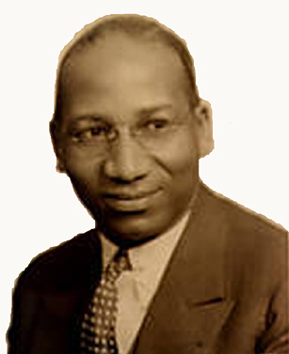
After Hayes formed his own orchestra, they performed at the Apollo Theatre in New York City and then began their first road tour, on August 12, 1937, in Youngstown, OH.
In the spring of 1938, they traveled through several countries of Europe and Asia.
Curiously, Hayes' band was the first to record Joe Garland's composition, In the Mood, on February 17, 1938 for Decca - preceding Glenn Miller, whose recording became a swing classic, by more than a year.
They also played such other uptempo pops and originals as Caravan, Edgar Steps Out, Blue Skies, Meet the Band, Fugitive From a Harem, and Swingin' in the Promised Land.
But it was his rendition of Star Dust which became Hayes' most popular number, and he kept it as his theme song. Besides recording it for Decca on February 17, 1938 (in fact, it was the flip side of In the Mood), he also did it on a V-Disc on May 25, 1946 and for the Modern label around 1948.
vital stats:
given name Edgar Junius Hayes
birth May 23, 1902, Lexington, KY
death June 28, 1979, San Bernardino, CA
education Fisk University, Nashville, TN; Bachelor of Music degree, Wilberforce University,
Wilberforce, OH
memberships ASCAP, 1955-; Executive Council, Los Angeles Pacific College, Los Angeles,
CA (later merged with Azusa Pacific University as Azusa Pacific College)
residence Riverside, CA (1970s)
Several sidemen with Hayes' 1937 orchestra had formerly played with him in The Mills Blue Rhythm Band: Shelton Hemphill, trumpet; Crawford Wethington, alto saxophone; Joe Garland, tenor saxophone; and Elmer James, bass.
Other members of Hayes' group included clarinetist and alto saxophonist Rudy Powell; drummer-vibraphonist Kenny Clarke, later to make a name for himself as a prominent bebop musician; and vocalist Ruth Ellington.
Hayes and his orchestra appeared in several southern U.S. cities in the fall of 1941 with a vaudeville package starring comedian Eddie "Rochester" Anderson.
Hayes disbanded shortly thereafter and moved to California, where he formed a quartet called his "Stardusters" and worked mainly around Los Angeles.
Later, on his own, he was pianist at the Somerset House in Riverdale, CA for 11 years, then from 1960 was a pianist at Reuben's restaurants in California.
An LP of piano solos by Hayes for Mark Records (no.MLP519), made around 1965, included, of course, Star Dust, as well as The Girl From Ipanema, What Kind of Fool Am I, and Hello, Dolly!.
sources:
"Edgar Hayes Back From A Tour Abroad," Chicago Defender, May 7, 1938, p.19.
"Edgar Hayes Band Stars Dance Tour," Chicago Defender, Aug. 14, 1937, p.10.
"Edgar Hayes On Tour With Rochester's Act," Chicago Defender, Oct. 4, 1941, p.21.
"Hayes, Edgar Junius," in ASCAP Biographical Dictionary, Fourth Edition (New York City:
R.R. Bowker Company, 1980), p.219.
Roger D. Kinkle, "Hayes, Edgar," in The Complete Encyclopedia of Popular Music and Jazz
1900-1950: Volume 2 Biographies A Through K (New Rochelle, NY: Arlington
House Publishers, 1974), pp.1067-1068.
---, "Hayes, Edgar," in Leading Musical Performers (Popular Music and Jazz) 1900 - 1950
(Mt. Vernon, IN: Windmill Publications, Inc., 1974), p.142.
Tom Lord, "Hayes, Edgar," in The Jazz Discography (West Vancouver, Canada: Lord Music
Reference, 1992), pp.H357-H358.
Brian Rust, "Edgar Hayes," in Jazz Records 1897-1942: Volume 1 Irving Aaronson to
Abe Lyman, 5th Revised and Enlarged Edition (Chigwell, Essex, England: Storyville
Publications and Co. Ltd., 1982), pp.695-696.
George T. Simon, "And Still More Bands: Edgar Hayes," in The Big Bands (New York
City: The Macmillan Company, 1967), p.506.
Floyd G. Snelson, "The South Hails Mills Blue Rhythm Band; On Long Tour," Chicago
Defender, June 22, 1935, p.7.
Social Security Death Index.
I would like to expand this tribute with, if possible, a new interview of someone who was important to Edgar Hayes' life or career. Are you an alumnus of his band, a member of his family, or a collector who is knowledgeable about his accomplishments? Please contact me via e-mail
return to "Biographical Sketches" directory
go to Big Band Library homepage
The big bands are back
in a new and exciting way!
EDGAR HAYES
"A SONG THAT WILL NOT DIE"
by Music Librarian CHRISTOPHER POPA
April 2009
He attended two of the earliest, historically African-American universities, Fisk and Wilberforce.
For six years beginning in 1931, he was the pianist and an arranger for the captivating Mills Blue Rhythm Band, led by Lucky Millinder.
"With due respect to my many other musical friends I think this outfit is the last word in hottest of the so-called hot jazz," Floyd G. Snelson reported, when they played Sunset Gardens in Atlanta, GA in 1935. "Edgar Hayes is given credit for the unusual arrangements that bring out the best that is in them."
